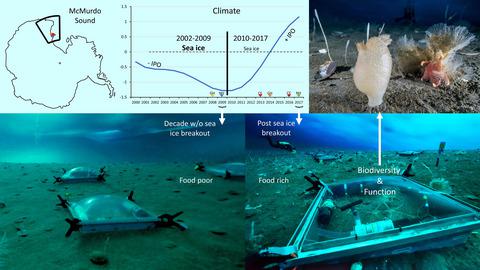当前位置:
X-MOL 学术
›
Glob. Change Biol.
›
论文详情
Our official English website, www.x-mol.net, welcomes your
feedback! (Note: you will need to create a separate account there.)
Climate cascades affect coastal Antarctic seafloor ecosystem functioning
Global Change Biology ( IF 10.8 ) Pub Date : 2021-09-28 , DOI: 10.1111/gcb.15907 Andrew M Lohrer 1 , Alf M Norkko 2, 3 , Simon F Thrush 4 , Vonda J Cummings 5
Global Change Biology ( IF 10.8 ) Pub Date : 2021-09-28 , DOI: 10.1111/gcb.15907 Andrew M Lohrer 1 , Alf M Norkko 2, 3 , Simon F Thrush 4 , Vonda J Cummings 5
Affiliation

|
Polar seafloor ecosystems are changing rapidly and dramatically, challenging previously held paradigms of extreme dynamical stability. Warming-related declines in polar sea ice are expected to alter fluxes of phytoplankton and under-ice algae to the seafloor. Yet, how changes in food flux cascade through to seafloor communities and functions remains unclear. We leveraged natural spatial and temporal gradients in summertime sea ice extent to better understand the trajectories and implications of climate-related change in McMurdo Sound, Antarctica. McMurdo Sound was expected to be one of the last coastal marine environments on Earth to be affected by planetary warming, but the situation may be changing. Comparing satellite observations of selected coastal sites in McMurdo Sound between 2010–2017 and 2002–2009 revealed more ice-free days per year, and shorter distances to open water during the warmest months each year, in the more recent period. Interdecadal Pacific Oscillation (IPO), Oceanic Niño Index (ONI) and Antarctic Oscillation (AAO) climate indices peaked concurrently between 2014 and 2017 when sea ice breakouts in McMurdo Sound were most spatially and temporally extensive. Increases in sediment chlorophyll a and phaeophytin content (indicating increased deposition of detrital algal food material) were recorded during 2014–2017 at three coastal study sites in McMurdo Sound following the major sea ice breakouts. Soft-sediment seafloor ecosystem metabolism (measured in benthic incubation chambers as dissolved oxygen and inorganic nutrient fluxes) was correlated with sediment algal pigment concentration. Epifaunal invertebrate density, particularly opportunistic sessile suspension feeders, and infaunal community composition also shifted with increased food supply. The ecological characteristics and functions measured at the food-poor sites shifted towards those observed at richer sites at a surprisingly fast pace. These results indicate the sensitivity of the benthos and shed light on Antarctic marine trophic cascades and trajectories of response of iconic high-latitude seafloor habitats to a warming climate.
中文翻译:

气候级联影响南极沿海海底生态系统功能
极地海底生态系统正在迅速而剧烈地变化,挑战着先前持有的极端动态稳定性范式。极地海冰变暖相关的减少预计会改变浮游植物和冰下藻类到海底的通量。然而,食物通量的变化如何级联到海底群落和功能仍不清楚。我们利用夏季海冰范围的自然时空梯度来更好地了解南极洲麦克默多湾气候相关变化的轨迹和影响。麦克默多湾预计将成为地球上最后一个受全球变暖影响的沿海海洋环境之一,但情况可能正在发生变化。比较 2010 年至 2017 年和 2002 年至 2009 年期间麦克默多湾选定沿海地点的卫星观测结果显示,每年的无冰天数更多,在最近的时期,在每年最温暖的月份,开放水域的距离更短。年代际太平洋涛动 (IPO)、大洋尼诺指数 (ONI) 和南极涛动 (AAO) 气候指数在 2014 年至 2017 年间同时达到峰值,当时麦克默多湾的海冰爆发在空间和时间上最为广泛。沉积物叶绿素增加一种2014 年至 2017 年期间,麦克默多湾的三个沿海研究地点在主要海冰破裂后记录了褐藻素含量(表明碎屑藻类食物材料的沉积增加)。软沉积物海底生态系统代谢(在底栖孵化室中测量为溶解氧和无机营养通量)与沉积物藻类色素浓度相关。表生无脊椎动物密度,特别是机会性无柄悬浮饲养者,以及底栖动物群落组成也随着食物供应的增加而发生变化。在食物匮乏的地点测量的生态特征和功能以惊人的速度转向了在食物丰富的地点观察到的生态特征和功能。
更新日期:2021-11-03
中文翻译:

气候级联影响南极沿海海底生态系统功能
极地海底生态系统正在迅速而剧烈地变化,挑战着先前持有的极端动态稳定性范式。极地海冰变暖相关的减少预计会改变浮游植物和冰下藻类到海底的通量。然而,食物通量的变化如何级联到海底群落和功能仍不清楚。我们利用夏季海冰范围的自然时空梯度来更好地了解南极洲麦克默多湾气候相关变化的轨迹和影响。麦克默多湾预计将成为地球上最后一个受全球变暖影响的沿海海洋环境之一,但情况可能正在发生变化。比较 2010 年至 2017 年和 2002 年至 2009 年期间麦克默多湾选定沿海地点的卫星观测结果显示,每年的无冰天数更多,在最近的时期,在每年最温暖的月份,开放水域的距离更短。年代际太平洋涛动 (IPO)、大洋尼诺指数 (ONI) 和南极涛动 (AAO) 气候指数在 2014 年至 2017 年间同时达到峰值,当时麦克默多湾的海冰爆发在空间和时间上最为广泛。沉积物叶绿素增加一种2014 年至 2017 年期间,麦克默多湾的三个沿海研究地点在主要海冰破裂后记录了褐藻素含量(表明碎屑藻类食物材料的沉积增加)。软沉积物海底生态系统代谢(在底栖孵化室中测量为溶解氧和无机营养通量)与沉积物藻类色素浓度相关。表生无脊椎动物密度,特别是机会性无柄悬浮饲养者,以及底栖动物群落组成也随着食物供应的增加而发生变化。在食物匮乏的地点测量的生态特征和功能以惊人的速度转向了在食物丰富的地点观察到的生态特征和功能。









































 京公网安备 11010802027423号
京公网安备 11010802027423号